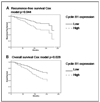Integrative analysis of cyclin protein levels identifies cyclin b1 as a classifier and predictor of outcomes in breast cancer
- PMID: 19470724
- PMCID: PMC2887710
- DOI: 10.1158/1078-0432.CCR-08-3293
Integrative analysis of cyclin protein levels identifies cyclin b1 as a classifier and predictor of outcomes in breast cancer
Abstract
Purpose: We studied the expression levels of cyclins B1, D1, and E1 and the implications of cyclin overexpression for patient outcomes in distinct breast cancer subtypes defined by clinical variables and transcriptional profiling.
Experimental design: The expression levels of cyclins B1, D1, and E1 were quantified in 779 breast tumors and 53 cell lines using reverse phase protein arrays and/or transcriptional profiling.
Results: Whereas cyclin E1 overexpression was a specific marker of triple-negative and basal-like tumors, cyclin B1 overexpression occurred in poor prognosis hormone receptor-positive, luminal B and basal-like breast cancers. Cyclin D1 overexpression occurred in luminal and normal-like cancers. Breast cancer subgroups defined by integrated expression of cyclins B1, D1, and E1 correlated significantly (P < 0.000001) with tumor subtypes defined by transcriptional profiling and clinical criteria. Across three hormone receptor-positive data sets, cyclin B1 was the dominant cyclin associated with poor prognosis in univariate and multivariate analyses. Although CCNE1 was present in significantly higher copy numbers in basal-like versus other subtypes (ANOVA P < 0.001), CCNB1 gene copy number did not show gain in breast cancer. Instead, cyclin B1 expression was increased in tumors with co-occurrence of TP53 mutations and MYC amplification, a combination that seems to characterize basal-like and luminal B tumors. CCNB1 gene expression was significantly correlated with PLK, CENPE, and AURKB gene expression.
Conclusion: Cyclins B1, D1, and E1 have distinct expressions in different breast cancer subtypes. Novel PLK, CENPE, and AURKB inhibitors should be assessed for therapeutic utility in poor prognosis cyclin B1-overexpressing breast cancers.
Conflict of interest statement
No potential conflicts of interest were disclosed.
Figures





References
-
- Gillett C, Smith P, Gregory W, et al. Cyclin D1 and prognosis in human breast cancer. Int J Cancer. 1996;69:92–99. - PubMed
-
- McIntosh GG, Anderson JJ, Milton I, et al. Determination of the prognostic value of cyclin D1 overexpression in breast cancer. Oncogene. 1995;11:885–891. - PubMed
-
- Seshadri R, Lee CS, Hui R, et al. Cyclin DI amplification is not associated with reduced overall survival in primary breast cancer but may predict early relapse in patients with features of good prognosis. Clin Cancer Res. 1996;2:1177–1184. - PubMed
-
- Han S, Park K, Bae BN, et al. Cyclin D1 expression and patient outcome after tamoxifen therapy in estrogen receptor positive metastatic breast cancer. Oncol Rep. 2003;10:141–144. - PubMed
Publication types
MeSH terms
Substances
Grants and funding
LinkOut - more resources
Full Text Sources
Other Literature Sources
Medical
Research Materials
Miscellaneous

